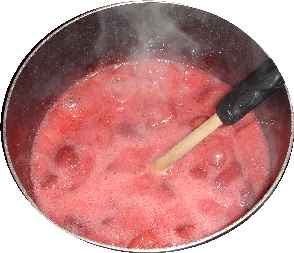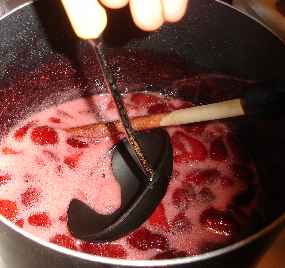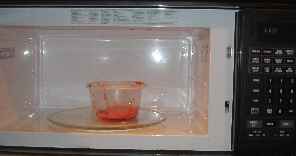Looking for Foam in Home Jam Making - What It Is and What To Do About It! in 2025? Scroll down this page and follow the links. And if you bring home some fruit or vegetables and want to can, freeze, make jam, salsa or pickles, see this page for simple, reliable, illustrated canning, freezing or preserving directions. There are plenty of other related resources, click on the resources dropdown above. If you are having a hard time finding canning lids, I've used these, and they're a great price & ship in 2 days.
If you have questions or feedback, please let me know! There are affiliate links on this page. Read our disclosure policy to learn more.
Foam in Home Jam Making - What It Is and What To Do About It!
 What To Do About the Foam on Your Jam!
What To Do About the Foam on Your Jam!
Your
are happily making jam, following the direction in a book or box of
pectin... until it says "skim the foam, or add 1 teaspoon of butter to
prevent foaming". Foam? Foaming? What is it? Does your jam have rabies?Nope, the foam is just the result of bubbles from the boiling jam coming up through the viscous jam. Just like a child blowing bubbles, the boiling jam produces bubbles.
Why remove it?
Well, it just doesn't taste very good. It doesn't taste bad, but it is not the consistency most people like in jam. It certainly won't hurt you, though. It might somewhat shorten the storage life of the jam. According to Janet Hackert, Nutrition Specialist, Northwest Region at the University of Missouri Extension:
Foam contains a lot of air. In canning, the jars are not filled to the top of the jar. This gap between the lid and the food is called head space and it gives the canned food room to "breathe." The food can expand during processing and form a vacuum as the jar cools. Foam in a jar of jam increases the head space. According to the Food Safety Information Service, this is not a problem if the jam is stored in a cool place and is eaten relatively soon. The extra head space does increase the chance of the jam molding after prolonged storage though.
What can I do about the foam
Besides making a B-grade horror movies with it, You can either prevent it or remove it.
Prevent it
1 teaspoon of butter, margarine or vegetable oil, added before you heat the mixture will almost eliminate it. On the downside, some food scientists worry that the small amount of butter could cause the batch to spoil sooner. I suspect this particular group of scientists probably still live at home...
Remove it
 When
I forget to add the butter (about 50% of the time), I just wait till I remove
the jam from the heat, let it sit for a minute or two and then skim the foam off
with a ladle.
When
I forget to add the butter (about 50% of the time), I just wait till I remove
the jam from the heat, let it sit for a minute or two and then skim the foam off
with a ladle.
I save the foam in a microwavable container. See below for why!
What can I do with the foam?

When I am done making jam for the day, I usually have about 1 cup of congealed foam. Looks a lot like a healthy lung. That's not very appealing to most people, so....
J ust
pop it into a microwave for 30 to 60 seconds or so on high. Be sure to
watch it the entire time, or it may boil over. You want to get it hot
again and to boil up a bit.
ust
pop it into a microwave for 30 to 60 seconds or so on high. Be sure to
watch it the entire time, or it may boil over. You want to get it hot
again and to boil up a bit.

Once you remove it and it cools, it will look, act and taste like regular jam again! Rather than attempting to put this back into a batch for canning, this is the jam I stick in the fridge to use fresh!
Blake's Easy and Illustrated Jam and Ice Cream Directions
I've got some other pages for specific types of jam, too:
Jams and jellies:
- How to make berry jams (strawberry, raspberry, blackberry, loganberry, mixed berry, etc.)
- How to make apple jelly
- How to make blueberry jam
- How to make apricot, peach, plum or nectarine jam.
- How to make fig jam
- NEW! How to make grape jelly from fresh grapes
- NEW! How to make muscadine or scuppernong jelly
- How to make orange marmalade
- Other jam recipes and jelly recipes.
- What happens if my jam or jelly doesn't gel? Remaking cooked runny jam or jelly instructions can be found on this page
Ice Cream, Gelato and Sorbets with your own fruit
- Electric and Manual ice cream makers that require ice and salt:
- NEW! How to make ice cream with your own fruit!
- NEW! How to make Gelato
- NEW! How to make sugar free, fat free ice cream
- Coming in September: How to make frozen yogurt
- Coming in September: How to make sorbet
- Electric ice cream makers that have a bowl that must be frozen in
your freezer:
- NEW! How to make ice cream with your own fruit!
- NEW! How to make Gelato
- NEW! How to make sugar free, fat free ice cream
- Coming in September: How to make frozen yogurt
- Coming in September: How to make sorbet
- Ice cream makers and manuals
- Lost your manual? We have most manuals here free to download!
- Looking for an ice cream maker? See reviews and information to select one and great prices, too
Summary - Typical Cost of Making Homemade Jam - makes 8 jars, 8 oz each** |
||||
| Item | Quantity | Cost in 2025 | Source | Subtotal |
| Berries (strawberries) | 1 gallon | $8.00/gallon | Pick your own | $8.00 |
| Canning jars (8 oz size), includes lids and rings | 18 jars | $11/dozen 8 oz jars or $0.92/jar |
Grocery stores, like Public, Kroger, Safeway and sometimes, Big Lots, local hardware stores and big box stores | $10.00 |
| Sugar | 4 cups | $2.00 | Grocery stores, like Public, Kroger, Safeway and sometimes, Big Lots, local hardware stores and big box stores | $2.00 |
| Pectin (low sugar, dry) | 1 and a third boxes * | $2.00 per box | Grocery stores, like Public, Kroger, Safeway and sometimes, Big Lots, local hardware stores and big box stores | $2.70 |
| Total | $22.70 total or about $1.25 per jar |
|||
| * pectin use varies - blackberry
jam needs very little, raspberry a little more, strawberry the most.
** - This assumes you already have the pots, pans, ladles,, and reusable equipment. Note that you can reuse the jars and reduce the cost further; just buy new lids (the rings are reusable, but the flat lids are not)! |
||||
Can't find the equipment? We ship to all 50 states!
Use our Feedback form!
FAQs - Answers to Common Questions
- Why should cooked jelly be made in small
batches?
If a larger quantity of juice is used, it will be necessary to boil it longer thus causing loss of flavor, darkening of jelly, and toughening of jelly. It really doesn't work. Trust me; I've tried many times! - Can I use frozen berries instead of fresh?
Yep! Raspberries can be particularly hard to find fresh and are expensive! Frozen berries work just fine, and measure the same. Just be sure to get the loose, frozen whole fruit; not those that have been mushed up or frozen in a sugar syrup! - Should jelly be boiled slowly or rapidly?
It should be boiled rapidly since long, slow boiling destroys the pectin in the fruit juice. - What do I do if there's mold on my jellied
fruit product?
Discard jams and jellies with mold on them. The mold could be producing a mycotoxin (poisonous substance that can make you sick). USDA and microbiologists recommend against scooping out the mold and using the remaining jam or jelly. - Why did my jellied fruit product ferment,
and what do I do?
Jellied fruit products may ferment because of yeast growth. This can occur if the product is improperly processed and sealed, or if the sugar content is low. Fermented fruit products have a disagreeable taste. Discard them. - What happens if my jam or jelly doesn't gel?
Remaking cooked runny jam or jelly instructions can be found on this page
Canning Books, Supplies and Accessories
These are my favorite essential canning tools, books and supplies. I've been using many of these for over 50 years of canning! The ones below on this page are just the sampling of. my preferred tools. but you can find much more detailed and extensive selections on the pages that are linked below.
- Vacuum Foodsealers for freezing, dried foods, and refrigerated foods - the FoodSaver line
- Selecting a KitchenAid mixer and attachments for home canning
- Steam Juicers
- Strainers, pit removers, seed-skin-stem removers, jelly strainers, etc. All types, makes and prices (from $19 to $350)
- Cherry pitters reviews, prices and ordering
- Food dehydrators - easy and fast to dry your own fruits, veggies, sun-dried tomatoes, etc.
The All New Ball Book Of Canning And Preserving: Over 350 of the Best Canned, Jammed, Pickled, and Preserved Recipes Paperback
This is THE book on canning! My grandmother used this book when I was a child.; It tells you in simple instructions how to can almost anything; complete with recipes for jam, jellies, pickles, sauces, canning vegetables, meats, etc.
If it can be canned, this book likely tells you how! Click on the link below for more information and / or to buy (no obligation to buy)The New Ball Blue Book of Canning and Preserving
Canning and Preserving for Dummies by Karen Ward
This is another popular canning book. Click here for more information, reviews, prices for Canning and Preserving For Dummies
Of course, you do not need to buy ANY canning book as I have about 500 canning, freezing, dehydrating and more recipes all online for free, just see Easy Home Canning Directions.
Home Canning Kits
See here for related tools, equipment, supplies on Amazon See here for related tools, equipment, supplies on Amazon
I have several canners, and my favorite is the stainless steel one at right. It is easy to clean and seems like it will last forever. Mine is 10 years old and looks like new.
The black ones are the same type of standard canner that my grandmother used to make everything from applesauce to jams and jellies to tomato and spaghetti sauce.
This complete kit includes everything you need and lasts for years: the canner, jar rack, Jar grabber tongs, lid lifting wand, a plastic funnel, labels, bubble freer, It's much cheaper than buying the items separately. It's only missing the bible of canning, the Ball Blue Book.
You will never need anything else except jars & lids (and the jars are reusable)!
The complete list of canners is on these pages:
- Water bath canners - Good for acidic foods, like applesauce, pickles, salsa, jams, jellies, most fruits
- Pressure canners - needed for low and non-acidic foods, like canned vegetables (corn, green beans, etc), and meats
- Canners for glass top stoves if you have a glass or ceramic stove
- Canners for induction stovetops
Pressure Canners
If you plan on canning non-acidic foods and low acid foods that are not pickled - this means: meats, seafood, soups, green beans corn, most vegetables, etc., then you ABSOLUTELY must use a Pressure Canner.
Of course, you can use a pressure canner as a water bath canner as well - just don't seal it up, so it does not pressurize. This means a Pressure Canner is a 2-in-1 device. With it, you can can almost ANYTHING.
There are also other supplies, accessories, tools and more canners, of different styles, makes and prices, click here!
Basic Canning Accessories
From left to right:
- Jar lifting tongs to pick up hot jars
- Lid sanitizer / lifter - to remove lids from the pot of boiling water (sterilizing )
- Lids- disposable - you may only use them once
- Ring - holds the lids on the jar until after the jars cool - then you remove them, save them and reuse them
- Canning Jar funnel - to fill the jars
FREE Illustrated Canning, Freezing, Jam Instructions and Recipes
Don't spend money on books. that you don't need to. Almost everything you can find in some book sold online or in a store is on my website here for free. Start with theEasy Home Canning Directions below. That is a master list of canning directions which are all based upon the Ball Bblue book, the National Center for Home Food Preservation and other reputable lab tested recipes. Almost every recipe I present in addition to being lab tested com. is in a step by step format with photos for each step and complete. explanations. that tell you how to do it, where to get the supplies and pretty much everything you need to know. In addition, there almost always in a PDF format so you can print them out and use them while you cook.
[ Easy Home Canning Directions]
[FAQs - Answers to common questions and problems]
[Recommended books about home canning, jam making, drying and preserving!]
Looking for canning equipment and supplies?
Water bath canner with a jar rack
Pressure canners for gas, electric and induction stoves: Presto 23Qt or T-fal 22Qt
Canning scoop (this one is PERFECT)
Ball Blue book (most recent version)
Jars: 8oz canning jars for jams
Find Other types of farms:
Farm markets and roadside stands
Road trips and camping resources
Local Honey, apiaries, beekeepers
Consumer fraud and scams information
Home canning supplies at the best prices on the internet!
Maple Syrup Farms, sugarworks, maple syrup festivals
Environmental information and resources
Farms For Your Event for birthday parties, weddings, receptions, business meetings, retreats, etc.
Festivals - local fruit and vegetable festivals
Get the
most recent version of
the Ball Blue Book
With this Presto 23 quart pressure canner and pressure cooker, you can "can" everything, fruits, vegetables, jams, jellies, salsa, applesauce, pickles, even meats, soups, stews. Model 01781

You can make jams, jellies, can fruit, applesauce, salsa and pickles with water bath canners, like this Granite Ware 12-Piece Canner Kit, Jar Rack, Blancher, Colander and 5 piece Canning Tool Set



